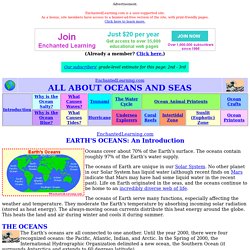

Whale Sharks - Whale Shark Pictures - Whale Shark Facts. As the largest fish in the sea, reaching lengths of 40 feet (12 meters) or more, whale sharks have an enormous menu from which to choose.

Fortunately for most sea-dwellers—and us! —their favorite meal is plankton. They scoop these tiny plants and animals up, along with any small fish that happen to be around, with their colossal gaping mouths while swimming close to the water's surface. Feeding The whale shark, like the world's second largest fish, the basking shark, is a filter feeder. The whale shark's flattened head sports a blunt snout above its mouth with short barbels protruding from its nostrils. Population Preferring warm waters, whale sharks populate all tropical seas. Although massive, whale sharks are docile fish and sometimes allow swimmers to hitch a ride. Whale Sharks - Whale Shark Pictures - Whale Shark Facts. Amazing Oceans. The oceans are unique to our planet.

No other planet in our solar system has liquid water. The oceans cover about 70% of the earth’s surface. They contain about 97% of the earth's water supply. Life on earth originated in the seas. The oceans continue to be home to an incredible number of plants and animals. We know very little about the oceans. Photo courtesy: richermcm, StockXchange. Life in the oceans. Photograph by Enric Sala, National Geographic The world's newest marine sanctuary, announced this week, encompasses 18,000 square miles (over 46,000 square kilometers) of ocean around the central African nation of Gabon.

(See "Gabon Announces World's Newest Underwater Reserve, Rich in Threatened Wildlife. ") The area is home to more than 20 species of sharks and rays, including threatened species like great hammerhead sharks, manta rays, whale sharks, and tiger sharks. (Read "Saving Africa's Eden" in National Geographic magazine.) Its protection had been a major aim of National Geographic's Pristine Seas project, which conducted a marine survey of parts of the nation's almost 500-mile (800-kilometer) coastline in 2012. In the pictures that follow, Sala and National Geographic photographer Michael "Nick" Nichols capture Gabon's vibrant underwater life. —By Kennedy Warne and Linda Qiu, photo gallery by Nicole Werbeck. Oceans. Simple Ocean Facts. Interesting Facts for Kids.

What causes high tide and low tide? Why are there two tides each day? The following diagram shows how the moon causes tides on Earth: In this diagram, you can see that the moon's gravitational force pulls on water in the oceans so that there are "bulges" in the ocean on both sides of the planet.

The moon pulls water toward it, and this causes the bulge toward the moon. Amount of trash. Threats to Coral Reefs. Earth's Oceans. Advertisement.

EnchantedLearning.com is a user-supported site. As a bonus, site members have access to a banner-ad-free version of the site, with print-friendly pages.Click here to learn more. (Already a member? Click here.) EnchantedLearning.comEARTH'S OCEANS: An Introduction. Ten Amazing Facts About Ocean Animals. Startling Images of the Tons of Trash in the World's Oceans. <br/><a href=" ABC US news</a> | <a href=" World News</a> Copy Nearly 270,000 tons of plastic are floating in the world's oceans, according to a new study.

That's divided into at least 5.25 trillion plastic pieces, researchers wrote. Or, enough to fill more than 38,500 garbage trucks, the Associated Press reported. "Plastics of all sizes were found in all ocean regions," said the report, published on Wednesday in the scientific journal PLOS ONE. AFP/Getty Images PHOTO: Plastic bags and other rubbish are collected from the waters and shoreline of Manila Bay during a campaign by environmental activists and volunteers calling for a ban of the use of plastic bags, July 3, 2014 UIG via Getty Images PHOTO: Juvenile Herring Gull with plastic rubbish in its beak, Newquay, Cornwall, England. How Do Oil Spills Occur. Why the Arctic is climate change's canary in the coal mine - William Chapman. NOAA - National Oceanic and Atmospheric Administration. People destroying coral. Nets are hurting animals. Ocean issues.